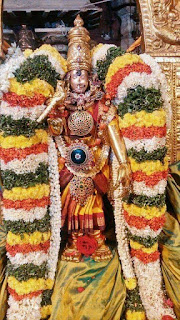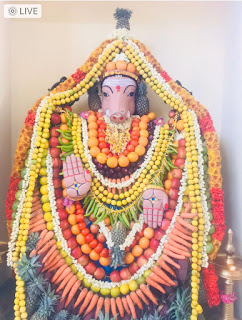विज्ञान-कलना (902)
Vijñāna-kalanā
Vijñāna means knowledge that is required to realise the Brahman and kalanā means causing or effecting. This nāma says that She provides the highest knowledge to realise the Brahman.
कल्या (903)
Kalyā
Kalya has many meanings such as auspicious, healthy, perfect, ready or prepared, instructive, dawn, good tidings, etc. It can be said that She is in the form of above qualities.
विदग्धा (904)
Vidagdhā
She is clever, shrewd, knowing, sharp, crafty, sly, artful, intriguing, etc. These qualities are required to create, sustain and dissolve the universe. These are the qualities of the Brahman and this nāma again reaffirms Her Brahmanic qualities.
बैन्दवासना (905)
Baindavāsanā
Baindava means a bindu or dot and āsana means seat. This nāma says that She is seated on a bindu.
तत्त्वाधिका (906)
Tattvādikā
She is beyond tattva-s or principles (generally tattva-s are twenty four or thirty six).
तत्त्वमयी (907)
Tattvamayī
She is the embodiment of tattva-s.
तत्त्वमर्थ-स्वरूपिणी (908)
Tattvamartha-svarūpiṇī
Tat means the Brahman and tvam means the soul. The union of the two is called realisation or Self-realisation. This nāma says She is in the form of mahā vākyas such as Tat tvaṁ asi or “You are That”. Her tat-tvaṁ form is the cause for Self-realisation.
सामगान-प्रिया (909)
Sāmagāna-priyā
Sāma means the Sāma Veda, gāna means songs and priyā means fond of. This nāma says that She is fond of songs of Sāma Veda, or She is fond of those who render Sāma Veda,. The verses of Sāma Veda, are rendered in musical notes. It is said that Śiva is fond of Sāma Veda.
सौम्या (910)
Saumyā
Somyā means ‘resembling the moon’, auspicious, happy, pleasant, cheerful, etc. All these characteristics apply to Her.
सदाशिव-कुटुम्बिनी (911)
Sadāśiva-kuṭumbinī
She's the consort of Sadāśiva and belongs to the family of Shiva.
सव्यापसव्य-मार्गस्था (912)
Savyāpasavya-mārgasthā
This nāma is composed of three words, savya + apa-savya + mārga. Savya means right hand, apa-savya means the left hand and mārga means path (possibly referring to middle path between savya and apasavya).
Savya is worshipping through Vedic methods, where only right hand is used to perform rituals. Apasavya is worshipping through tantric methods, where only left hand is used. This nāma says that She is worshipped by Her devotees by either of these paths. These are also known as dakṣiṇā mārga and vāma mārga.
सर्वापद्-विनिवारिणी (913)
Sarvāpad-vinivāriṇī
She is the eliminator of all kinds of misfortunes.
स्वस्था (914)
Svasthā
Svasthā means being in one’s natural state and as own natural self with a healthy body and mind without upādhi-s (disturbance). Because of being the highest, She is Svasthā.
स्वभाव-मधुरा (915)
Svabhāva-madhurā
She is sweet, pleasant, charming and delightful in nature. Because of these qualities everyone is attracted to Her.
धीरा (916)
Dhīrā
She is the embodiment of strength.
धीर-समर्चिता (917)
Dhīra-samarcitā
She is adored by scholars.
चैतन्यार्घ्य-समाराध्या (918)
Caitanyārghya-samārādhyā
Caitanya is the foundational consciousness that has absolute freedom of knowing and doing.
Arghya means the water offered to respectable guests. This nāma says that She is worshipped with consciousness as offerings.
चैतन्य-कुसुम-प्रिया (919)
Caitanya-kusuma-priyā
She is very fond of kusum flower. Here consciousness is compared to flower by poets.
सदोदिता (920)
Sadodita
She's eternally shining
सदा-तुष्टा (921)
Sada-tusta
She always remains satisfied
तरुणादित्य पाटला (922)
Tarunaditya-patala
Her color is as red as the rising Sun. Patala means pale red, more of red and less of white. Red is compared to Sakthi and white is compared to Siva. While sustaining the universe, Her qualities are more predominant than that of Siva.
दक्षिणादक्षिणाराध्या (923)
Daksina-Daksinaradhya
Right hand worshippers are called Dakshinacara and left hand worshippers are called vamacara . She's adored by both.
दरस्मेरमुखाम्बुजा (924)
Darasmera - mukhambuja
Her face is full of smile comparable to a fully blossomed lotus.
कौलिनी केवला (925)
स्तोत्रप्रिया (927)
Stotra - priya
Stotra means a hymn of praise. She's fond of praise by verses like SriDevi Mahatyam, Sri Sukta, Durga Suktham, etc.
स्तुतिमती (928)
Stuti mati
Stuti means praise, mati means knowledge. One gets the knowledge required to realise Brahman by praising Her through Stotra.
श्रुतिसंस्तुतवैभवा (929)
Sruti - Samstuta - vaibhava
She's celebrated through Vedas.
मनस्विनी (930)
Manasvini
She has equanimous mind.
मानवती (931)
Mānavati
She has a high mind of high that comprises of compassion and forgiveness. Because of this quality, She is adored as Sri Mātā or the Divine Mother.
महेशी (932)
Mahesi
Wife of Mahesśvarā (Šiva). She originated from Maheśvara.
मडगलाकृति: (933)
Mangalakrtih
Mangal means auspiciousness, happiness, felicity, welfare. This nāma says that She is the embodiment of these.
विश्वमाता (934)
Visvamata
Visva means all-pervading, all-containing, omnipresent, in particular Lord Vishnu. This nama says She's the mother of Vishnu
जगद्धात्री (935)
Jagaddhatri
She supports and sustains the universe
विशालाक्षी (936)
Visalakshi
She has large eyes that are expansive, auspicious, and full of compassion. Lalithambika doesn't have abhaya and varada hastas. She offers these through Her eyes.
विरागिणी (937)
Viragini
She's devoid of passion.
प्रगल्भा (938)
Pragalbha
She's bold, confident and behaved resolutely.
परमोदारा (939)
Paramodara
She's extremely generous
परामोदा (940)
Para-moda
She's the embodiment of supreme joy
मनोमयी (941)
Manomayi
She's the embodiment of mind. She's capable of transmuting the mundane mind into divine consciousness , where Siva is revealed.
व्योमकेशी (942)
Vyoma-kesi
Vyoman means heaven, sky, atmosphere, ether, air, wind ,etc and kesa means hair. Her hair is said to be akas element.
विमानस्था (943)
Vimanastha
Residing in Chakrarajam chariot, She's occupied with protecting Her devotees.
वज्रिणी (944)
Vajrini
Bedecked with diamonds and gems, She holds vajrayudha in Her hands to destroy sinners.
Siva is vajra and Sakthi is Vajrini.
वामकेश्वरी (945)
Vamakeswari
Vamakeswara tantra, the sixty fifth tantra, is said to be the most important tantra for Srividya worship. She's the presiding deity of Vamakeswara tantra. Hence Vamakeswari.
पञ्चयज्ञप्रिया (946)
Pancha-yagna-priya
Pancha means five, yagna means worship, devotion and sacrifice . Vedas and Upanishads talk about five types of yagnas. She's fond of such yagnas. (agnihotrA,
darshapUrnamAsa, chAturmAsya, goyaj~na and somayaj~na)
पञ्चप्रेतमञ्चाधिशायिनी (947)
Pancha-preta-manchadhi-sayini
Pancha Preta means Brahma, Vishnu, Rudra, Mahadeva and Sadashiva and they are the legs of the throne that She's seated upon.
पञ्चमी (948)
Panchami
Varahi Devi is known as Panchami, since she's the fifth among the Sapta mathas .
Sadashiva is also known as Panchama and his wife is Panchami.
पञ्चभूतेशी (949)
Pancha-bhutesi
She's the embodiment and the ruler of the five elements , space , air, fire, water and earth.
पञ्चसङ्ख्योपचारिणी (950)
Pancha-samkhyopacharini
She's worshiped with five types of offerings, gandha (sandal paste), pushpa, dhoopa , dheepa and nivedhya . Each one of them represent the five elements, earth, akas, air, fire and water.
















No comments:
Post a Comment